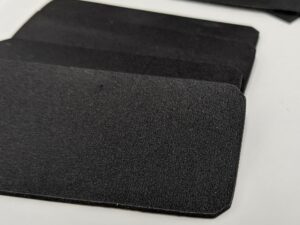
PORON pads for battery cushions
At NEDC, we manufacture a lot of products. Battery Cushion Pads are a common product we make. Customers who are making a modular electronic, oftentimes have a battery that also requires cushioning, or thermal cooling.
What are Battery Cushion Pads Used for?
Battery Cushion Pads have two different functions that I wanted to point out. The first is- simply cushioning the pad with a soft pad that helps to isolate it from impacts, and drops that are common in modular electronics. The second is a pad that not only isolates the battery from drops, and impacts but also helps cool the battery.
Note: Both of these pads/cushions can take up space between the cover to the electronic, and the battery. The good compression that is available from the materials below allows for this space to be taken up.
Materials that can be Die-Cut for Battery Pack Cushions/Pads
1st- Foams such Rogers Foam products including PORON and BISCO are good materials that keep good compression against the batteries while also maintaining good resilience against drops/impacts/vibration for the battery. There are two different types of foam here, PORON Urethane Foam, and BISCO Silicone Foam. The good thing about
HT-870 – Soft Silicone Foam, 4 psi @ 25% compression, UL 94V0
HT-800 – Medium Silicone Foam, 9 psi @ 25% compression, UL 94 V0
BF-1000 – Extra Soft Silicone Foam, 2.4 psi @ 25% compression, UL 94 V0
PORON 4701-30, Very Soft Urethane Foam, (20 lb density, 5 psi @ 25% compression \ 25 lb density, 8.4 psi @ 25% compression)
PORON EVExtend 43HBF, Medium Urethane Foam, 6 psi @ 25% compression
2nd- Thermacool R-10404 Silicone Sponge which is thermally conductive. This foam serves two purposes.
- It protects the battery, and other components against impact, and shocks that can be prevalent in modular electronics.
- It helps cool the battery through its great thermal performance. (R10404 is the ONLY thermally conductive silicone sponge that I know of)
Thermacool R-10404 Silicone Sponge –Medium, 18 psi @ 25% compression
Why does the Batterys Life Matter?
It’s important to realize that in electronics, the batteries life could be argued to be the most important component in the entire electronic. Batteries will operate more efficiently, and will have a longer life when they have a carefully controlled temperature range. Years can be taken off a batteries life by just a few degrees changed consistently.
Adhesive Backing for Battery Cushion Pads
Having an adhesive backing for your battery cushion pad may be a good idea to help in assembly, and make it stick to the top of casings, or covers.
3M 467MP- this lower tack adhesive that can add up to high adhesive strength over time is a good choice.
3M 9472LE/9471LE- the lower surface energy plastic backings, and surfaces that are ubiquitious in commercial electronics can be difficult to stick to. In cases such as those, having a low surface energy tape to match may be a good idea.
More Information
NEDC die-cuts, and waterjet cuts battery cushion pads. If you feel you have an application that could utilize a battery cushion pad made out of silicone, or urethane foam – or any other polymer let us know. For more information on soft cushion pads for battery packs, please contact sales@nedc.com.
Rogers High Performance Materials for EV Battery Packs Brochure Download
HT-870 Silicone Foam Datasheet Download
HT-800 Silicone Foam Datasheet Download
BF-1000 Silicone Foam Datasheet Download
PORON 4701-30 Datasheet Download